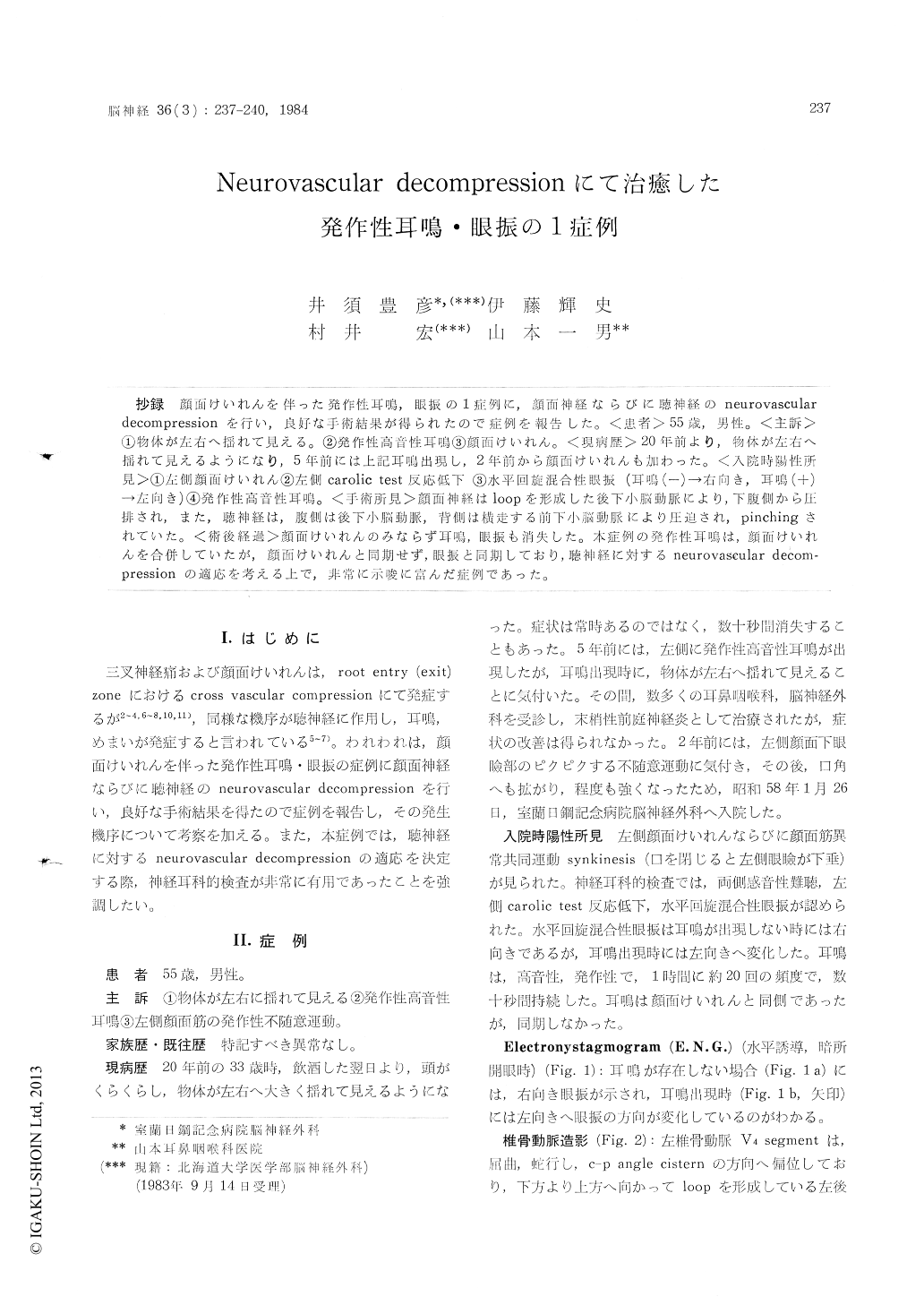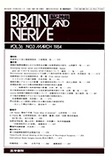Japanese
English
- 有料閲覧
- Abstract 文献概要
- 1ページ目 Look Inside
抄録 顔面けいれんを伴った発作性耳鳴,眼振の1症例に,顔面神経ならびに聴神経のneurovasculardecompressionを行い,良好な手術結果が得られたので症例を報告した。〈患者〉55歳,男性。〈主訴〉①物体が左右へ揺れて見える。②発作性高勘性耳鳴③顔面けいれん。〈現病歴〉20年前より,物体が左右へ揺れて見えるようになり,5年前には上記耳鳴出現し,2年前から顔面けいれんも加わった。〈入院時陽性所見〉①左側顔面けいれん②左側carolic test 反応低下③水平回旋混合性眼振(耳鳴(一)→右向き,耳鳴(+)→左向き)④発作性高音性耳鳴。〈手術所見〉顔面神経はloopを形成した後下小脳動脈により,下腹側から圧排され,また,聴神経は,腹側は後下小脳動脈,背側は横走する前下小脳動脈により圧迫され,pinchingされていた。〈術後経過〉顔面けいれんのみならず耳鳴,眼振も消失した。本症例の発作性耳鳴は,顔面けいれんを合併していたが,顔面けいれんと同期せず,眼振と同期しており,聴神経に対するneurovascular decom—pressionの適応を考える上で,非常に示唆に富んだ症例であった。
Trigeminal neuralgia and facial spasm are usu-ally caused by cross vascular comression of the trigeminal root entry zone and facial nerve exit zone. A similar mechanism is believed to affect the acoustic nerve as well, giving rise to tinnitus and nystagmus. We present one case of paroxysmal tinnitus and nystagmus, accompanied by facial spasm, and discuss the mechanism and the signi-ficance of the neurootological examination.
Case report
This 55-year-old man was admitted to the hos-pital with a chief complaint of oscillation of vision, paroxysmal tinnitus, and twitching of facial muscle. He had started feeling dizzy in the head 20 years age when he was 33. Five years ago, he had de-veloped a highpitched type of tinnitus in the left ear. Two years prior to admission, he has noticed facial spasm on the same left side as tinnitus. The positive diagnostic findings on admission were facial spasm on the left side and synkinesis. The neuro-otological examination showed that the pa-tient had a diminution of auditory acuity in high tones, partial loss of response of the vestibular apparatus to caloric stimulation on the left side, nystagmus of the horizontal and the rotary types. His nystagmus combining the horizontal and rotary types was found to be clockwise in motion when he had no fit of tinnitus, but in turn counterclock-wise when he came to have that fit. His tinnitus was high pitched and paroxysmal.
Surgical findings: The patient underwent a ret-romastoid craniectomy in the contralateral, lateral decubitus position and microvascular decompres-sion using microsurgical technique. The facial nerve at its exit zone was being compressed and displaced from the inferoventral side by the ab-normal loop forming posterior inferior cerebellar artery that had been earlier confirmed by angio-graphy. It was also found that the acoustic nerve was being pressurized from superodorsal side by the anterior inferior cerebellar artery that traver-sed the nerve. The superior part of the acoutic nerve corresponding to the superior vestibular nerve was found to have thinned down and dis-colored. The abnormal loop-forming posterior inferior cerebellar artery that was sinking to the ventral side of the facial nerve was turned up to the dorsal side of the acoustic nerve to isolate the artery from the nerve, and the isolation was com-pletely made by inserting muscle.
The post-operative state in this case has proved excellent. The patient has been completely relieved of not just his facial spasm, but his tinnitus and nystagmus.

Copyright © 1984, Igaku-Shoin Ltd. All rights reserved.


